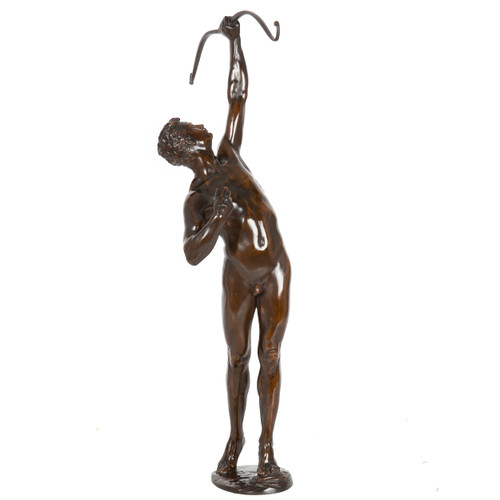catalog text
JOSEPH JOHANNES UPHUES
German, 1850-1911
"Hercules and the Stymphalian Bird" or "The Archer"
Patinated bronze | signed to base in script "J. Uphues" and sealed with foundry cachet of Gladenbeck & Söhn | conceived 1884, cast circa 1890-1910
Item # 301BVP23S
A fluid and sinuous depiction of Hercules the moment after releasing an arrow from his bow to kill the Stymphalian birds, it was one of Joseph Uphues' most sought-after classical works. The curvature of the man's body follows a perfect cyma and every muscle is tensed as he releases the string and lets the arrow fly. It is silky and expertly cast, finished in a translucent medium-brown patina with reddish undertones.
Uphues modeled a variation of this model with the archer wearing a fig leaf. He also made a model depicting the archer after the hunt, the victorious Hercules grasping one of the downed birds in his left hand, the other arm upraised with the bow - an example of that was offered at Christies, London in July of 2010, a 25 1/2" high model that achieved 4375 GBP (or approximately $ 6850 USD at 1.53 conversion the date of the sale). A 38" example of this sculpture is held in the permanent collection of the National Gallery of Victoria (acc. no. p.58.3-1).
As part of his sixth labor, Hercules is told to drive these birds away from the town of Stymphalos. Deep in the woods at Lake Stymphalus in Greece, an enormous flock of the birds are gathered, able to hide and be nearly impossible to find until too late. They are deadly creatures described as vicious man-eaters with feathers like poisonous arrows that they use to paralyze their victims, using their iron-like beaks and claws to tear their captured prey apart to eat while still alive. The goddess Athena gives to Hercules krotala, a pair of copper noisemakers that are capable of driving the birds from their hiding places. Climbing a nearby mountain, Hercules vigorously works the krotala and as the vast flock of birds takes to the air, he uses his bow to shoot them down.
The base of the present example is sealed with the foundy cachet embossed AKTIEN GES / VORM H. GLADENBECK & SOHN / FRIEDRICHSHAGEN.
Gladenbeck & Sohn was one of the most important and well-regarded foundries in Germany. The company was founded in Berlin by Hermann Gladenbeck in 1851 and in 1857 they expanded operations when they took over the Royal Foundry in Berlin. Gladenbeck was moved to Friedrichshagen in 1887 and the following year they were reorganized as Aktien-Gesellschaft and began to mark their bronzes with variations of Aktien-Ges Vorm H. Gladenbeck & Sohn, which loosely translates to "The Aktien Company, Formerly H. Gladenbeck & Sons". They continued to operate in this entity until 1911 when they became known as Gladenbeck Bronzegieβerei. The company continued to operate until its bankruptcy in 1926.
JOSEPH UPHUES
Born in 1850, Joseph Uphues studied at Berlin's Akademie der Künste starting in 1878 under the tutelage of Reinhold Begas and Fritz Schaper. Four years later he joined Reinhold Begas as a Master Student and continued to work for him through 1891, opening his own studio the following year. He joined Berlin's Secessionist movement in 1899 and the following year he won a silver medal at the Exposition Universelle.
Examples on the open market:
- Christies, London, 18 February 2013, lot 378, 15 1/4" high (smaller model), achieved 3125 GBP (at 1.55 conversion rate on date of sale, approximately $ 4840 USD)
- Christies, London, 18 February 2003, lot 279, 23 3/4" H including marble (identical height to present example), achieved 4541 GBP (at 1.63 conversion rate on date of sale, approximately $ 7400 USD)
References:
- E. Benezit Dictionary of Artists, Vol. XIII, Gründ, 2006, p. 1358
- Bronzes: Sculptors & Founders 1800-1930, Vol. III, Berman, 1977, p. 695, fig. 2546 [present example pictured without a marble base, noted as being cast in editions of 23" and 14"]
- Bronzes: Sculptors & Founders 1800-1930, Vol. IV, Berman, 1980, p. 917, fig. 3501 [an example of the Victorious Archer mentioned in the text, offered in 14 1/2" and 19"]
Measurements: 22 5/8" H x 3 7/8" D x 5 1/4" W
Condition Report:
Bow is curved outward slightly at the end - remnants of copper are bound around the tips of the bow of wire that was at one point strung across. Bow reshaped at the hand with associated touchups to patina at joint of hand with bow. Some light scuffs to the patina throughout the figure's body and discoloration around his proper left eye. Carefully cleaned and waxed, a fine presentation.






































